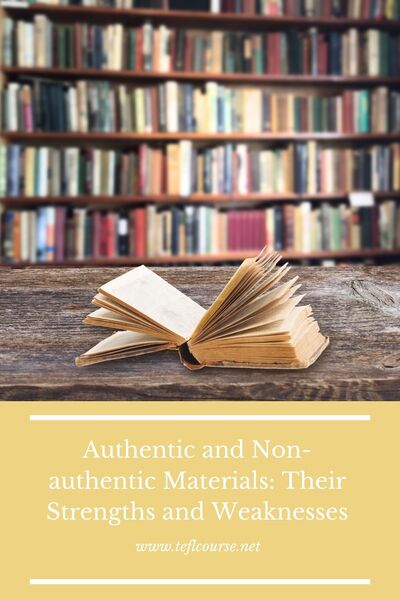Authentic and Non-Authentic Materials: Their Strengths and Weaknesses

Imagine you are in a language class and the teacher has given you a task. You are excited. The last time you completed an assignment like this one you gained a greater sense of confidence in the target language. After completing the last assignment the confidence gained from it gave you the courage to strike up a conversation with the waiter at the restaurant where you were dining. He was from the country of your target language. You said "hello" and also read the menu and ordered it in the TL. Why? Where did this confidence come from? I do not want to oversimplify the answer because learning a language takes time and effort, it is a compilation of many things, but in this instance, the reason is that your teacher brought a menu from a local restaurant during the last several classes. You learned a vocabulary about food and how to order food. You also talked about formal verb cases which particularly made you pleased when the waiter commented on your politeness. This encounter not only delighted you and gave you confidence; it also motivated you to learn more about the TL. Confidence and practicality lead hand in hand to motivation. If you have no confidence and see no use for using the TL in your own life, then you lack motivation and give up learning it. One of the ways we can give our students motivation through confidence and practicality is through the materials we choose to use.
Table of Contents
Materials are anything you bring into the classroom to aid you in teaching.
The biggest pro of Authentic Materials is the confidence it gives the student after completion.
Do you want to teach English abroad? Take a TEFL course today!
This post was written by our TEFL certification graduate Samuel S. Please note that this blog post might not necessarily represent the beliefs or opinions of ITTT.
Materials are anything you bring into the classroom to aid you in teaching.
They can be categorized into two broad areas, Authentic and Non-authentic materials. Authentic Materials are materials you would find in the daily life of the people of your TL. It might be a newspaper article, a movie, or a TV show. It could also be a book, song, or poetry in the TL. Non-authentic Materials are any materials that you make or are made specifically for language learning in the classroom. There are advantages and disadvantages to each.
Also Read: Why You Should Take Specialized TEFL Courses | ITTT | TEFL Blog
The biggest pro of Authentic Materials is the confidence it gives the student after completion.
It gives this because it has a real-life application and practicality of it. It also is a good barometer for the student. If a student cannot read a menu from a local restaurant in the TL then he or she has something practical to aim for. If there is a restaurant around then a good step to take might be to go there and speak only in the TL or order in the TL. So if you bring into your class an actual menu in the TL, and learn food vocabulary as well as a few verbs to "order," you can make learning fun and practical. One of the biggest drawbacks to learning a second language (L2) is that generally the student becomes disinterested and or discouraged due to lack of confidence and use of the L2 in their normal, daily lives. A good way to counter this is to choose an Authentic Material and create communicative activities around it, as mentioned above. (If there is no restaurant in the TL near you, you could bring some food to class and have the students "order" what they would like.)
Also Read: Teaching English in South Korea - Should you Teach in The Countryside or City?
The biggest weaknesses of Authentic Materials are that it can take a lot of your time to find authentic material that is right for your class.
It is also easy for the student to be overwhelmed with new vocabulary and grammar structures in Authentic Materials. Generally, Authentic Materials are more suited for higher levels for this reason. Thus if you cannot find the right Authentic Materials for the level of your class, make your own! With Non-authentic Materials you can create them at a particular level, and not overwhelm your students. Non-authentic Materials should be as Authentic as possible. As in the menu example above, you might have to create your menu. That's fine. Make it as real as possible to enhance your students' confidence.
Do you want to teach English abroad? Take a TEFL course today!
The psychological benefit of Authentic Materials applies more to the older learner, thus the Non-authentic materials are often better for the younger learner. Authentic and Non-authentic Materials are both useful. As the language level of your students' progress, you will be able to find and use more Authentic Materials to use along the way. This leads to confidence and practicality, which produces motivation!
Apply now & get certified to teach english abroad!
Speak with an ITTT advisor today to put together your personal plan for teaching English abroad!
Send us an email or call us toll-free at 1-800-490-0531 to speak with an ITTT advisor today.
Related Articles:
- 10+ Activities For Teaching English Winter Camp
- Top 10 Things To Know When Moving Abroad To Teach English
- 7 Activities for Teaching Reported Speech in the ESL Classroom
- What TEFL course is most useful?
- Great Ideas for Teaching Listening Skills in the ESL Classroom
- The Best Countries to Teach ESL When You're 50+




